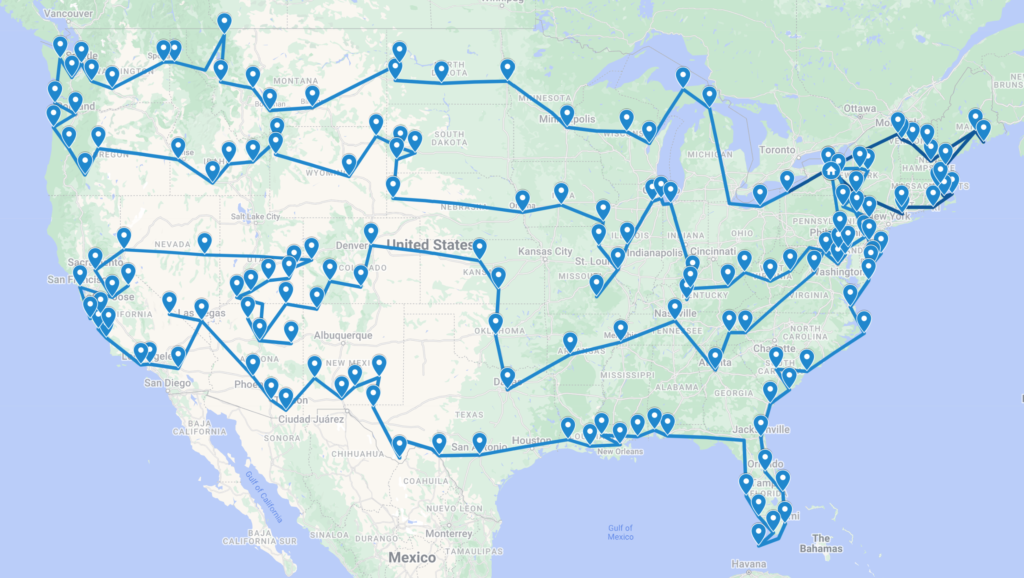So you built your first house?
Rear Seat Removal
The first step in our build process required taking out the rear seats of the Prius. We knew we would be building a platform to sleep on, and removing the seats would not only provide more storage space but also a place to attach the bed frame to the vehicle. Big thanks to this Instructable on how to remove the rear seats. This process was surprisingly easy, as it only required taking off some plastic covers and unscrewing the bolts. The bench seats came right out on their sliding rails in just two large pieces. The amount of space in the back is really impressive with the seats gone! We also removed the spare tire in the trunk space for even more storage room.
Attaching the Frame
The frame is attached to the car using the existing bolts from the rear seats. We used heavy-duty L-Brackets in four spots attached to the lower two-by-fours of the bed frame. The main weight of the bed frame rests exactly where the rear seats sat. The area that used to be under the rear seats was not flat, but the two-by-fours allowed plywood to be laid across this area providing a level surface for our gear in the final build. By chance, the outside two-by-fours bolted to the car lay exactly four feet apart. This made width measurements for the bed platform far easier, and was a major plus considering plywood comes standard in four-foot sheets.
Frame Structure
We decided to make the frame out of wood. This was the lightest, most economical, and easiest option. The frame was designed to raise the bed about 10 inches above the back floor. This would allow extra storage under the bed, and access to the spare tire well, all while staying below the back window for complete visibility. The main structure of the frame is built with two-by-three wooden beams. We cut these using a hand saw and miter box. In the front, there are several tall two-by-two support struts holding the bed steady above the area of the rear seats. The frame was built in sections with wood screws. The entire frame can be disassembled and rebuilt in the car, there are five main pieces connected with large hex screws.
Bed Platform
The back hatch opening measures only three feet and ten inches wide, meaning the four-foot bed platform had to be constructed in several pieces instead of one big section. Fortunately, Home Depot was willing to cut plywood to size for us. The frame had been constructed specifically to allow three plywood pieces on top. We ended up with two, two-foot sections with a one-and-a-half-foot piece in the middle. Making the bed platform five and a half feet long and four feet wide. We then stapled a thin carpet to the plywood to make it more comfortable (Thanks to Shelby’s dad for the stapler!). We used just a few screws to hold the carpeted platform in place on the frame.
The Bottom Cover
The rear seat removal provided ample space but introduced a new problem. Under the seats existed an uneven network of vents, electrical ducts, and support structures. Some of this was important battery ventilation that we did not want to block once we started filling the car with our stuff. Fortunately, the bottom two-by-fours of the frame provided a solution. Their level surface allowed for another plywood platform, this one below the bed where the rear seats had been. We custom cut plywood to fit in this area using a circular saw and oscillating multi-tool (Thanks to Spencer’s Dad for the tools!). And we covered this plywood with spare carpet leftover from the top platform. Now we had a large flat surface in this space that also helped to hold the frame together. We screwed part of this to the frame but left one piece free to be removed. If needed we could stow rarely used or valuable odds and ends in this area under the plywood.
Final Touches
It was important for us to keep in mind how we would interact with the bed platform on the trip. We knew throughout the build that we wanted a small car fridge so, we made sure to keep space behind the passenger seat free. We also made sure to allow access to the trunk area, and luckily had a couple of bins that fit perfectly in the back above the trunk hatch. We also got a thin four-foot aluminum bar that we bent to follow the curve of the car headliner and wedged in the support columns of the front seat belts. This provided a curtain “rod” for privacy in the back of the vehicle. As a finishing touch, we added a set of string LED lights around the frame for a cozy aesthetic. To complete the build our bed is a four-inch memory foam mattress topper we cut to size to fit the platform.














































